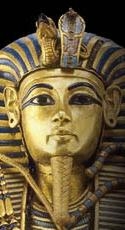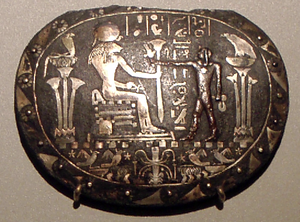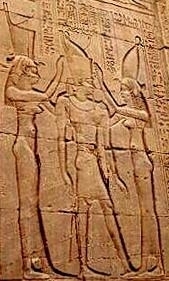
Two Ladies
Encyclopedia

Euphemism
A euphemism is the substitution of a mild, inoffensive, relatively uncontroversial phrase for another more frank expression that might offend or otherwise suggest something unpleasant to the audience...
for Wadjet
Wadjet
In Egyptian mythology, Wadjet, or the Green One , was originally the ancient local goddess of the city of Dep , which became part of the city that the Egyptians named Per-Wadjet, House of...
and Nekhbet
Nekhbet
In Egyptian mythology, Nekhbet was an early predynastic local goddess who was the patron of the city of Nekheb, her name meaning of Nekheb...
, the deities
Deity
A deity is a recognized preternatural or supernatural immortal being, who may be thought of as holy, divine, or sacred, held in high regard, and respected by believers....
who were the patrons of the Ancient Egyptians and worshiped by all after the unification of its two parts, Lower Egypt
Lower Egypt
Lower Egypt is the northern-most section of Egypt. It refers to the fertile Nile Delta region, which stretches from the area between El-Aiyat and Zawyet Dahshur, south of modern-day Cairo, and the Mediterranean Sea....
, and Upper Egypt
Upper Egypt
Upper Egypt is the strip of land, on both sides of the Nile valley, that extends from the cataract boundaries of modern-day Aswan north to the area between El-Ayait and Zawyet Dahshur . The northern section of Upper Egypt, between El-Ayait and Sohag is sometimes known as Middle Egypt...
. When the two parts of Egypt were joined together, there was no merger of these deities as often occurred with similar deities from various regions and cities. Both goddesses were retained because of the importance of their roles and they became known as the two ladies, who were the protectors of unified Egypt
Ancient Egypt
Ancient Egypt was an ancient civilization of Northeastern Africa, concentrated along the lower reaches of the Nile River in what is now the modern country of Egypt. Egyptian civilization coalesced around 3150 BC with the political unification of Upper and Lower Egypt under the first pharaoh...
.
After the unification, the image of Nekhbet joined Wadjet on the uraeus
Uraeus
The Uraeus is the stylized, upright form of an Egyptian spitting cobra , used as a symbol of sovereignty, royalty, deity, and divine authority in ancient Egypt.The Uraeus is a symbol for the goddess Wadjet, who was one of the earliest Egyptian deities and who...
, thereafter, they were shown together as part of the crowns of Egypt. An example of one is shown in the photograph to the right. The two ladies were responsible for establishing the laws, protecting the rulers
Monarch
A monarch is the person who heads a monarchy. This is a form of government in which a state or polity is ruled or controlled by an individual who typically inherits the throne by birth and occasionally rules for life or until abdication...
and the Egyptian country
Country
A country is a region legally identified as a distinct entity in political geography. A country may be an independent sovereign state or one that is occupied by another state, as a non-sovereign or formerly sovereign political division, or a geographic region associated with a previously...
, and promoting peace
Peace
Peace is a state of harmony characterized by the lack of violent conflict. Commonly understood as the absence of hostility, peace also suggests the existence of healthy or newly healed interpersonal or international relationships, prosperity in matters of social or economic welfare, the...
.
The holiest of deities in the Egyptian pantheon
Egyptian pantheon
The Egyptian pantheon consisted of the many gods worshipped by the Ancient Egyptians. A number of major deities are addressed as the creator of the cosmos. These include Atum, Ra, Amun and Ptah amongst others, as well as composite forms of these gods such as Amun-Ra. This was not seen as...
usually were referred to by such euphemisms or other euphemistic titles—sometimes in great chains of titles—in order to keep their names secret from enemies and disbelievers and, to show respect for their powers.
An example of the use of this term in text references may be found in the following commemoration of a military campaign under pharaoh Amenhotep III
Amenhotep III
Amenhotep III also known as Amenhotep the Magnificent was the ninth pharaoh of the Eighteenth dynasty. According to different authors, he ruled Egypt from June 1386 to 1349 BC or June 1388 BC to December 1351 BC/1350 BC after his father Thutmose IV died...
recorded on three stelas carved from rock. In the text he is referred to as Nebmaatra. They are from his fifth year and were found near Aswan
Aswan
Aswan , formerly spelled Assuan, is a city in the south of Egypt, the capital of the Aswan Governorate.It stands on the east bank of the Nile at the first cataract and is a busy market and tourist centre...
and Sai Island
Saï (island)
Saï is a large island in the Nile River in Nubia between the second and third cataracts. It is 12 km long and 5.5 km wide. Saï was intermittently occupied by the Egyptians during the New Kingdom.-External links:* *...
in Nubia
Nubia
Nubia is a region along the Nile river, which is located in northern Sudan and southern Egypt.There were a number of small Nubian kingdoms throughout the Middle Ages, the last of which collapsed in 1504, when Nubia became divided between Egypt and the Sennar sultanate resulting in the Arabization...
. The official account of his military victory emphasizes his martial prowess with the typical hyperbole
Hyperbole
Hyperbole is the use of exaggeration as a rhetorical device or figure of speech. It may be used to evoke strong feelings or to create a strong impression, but is not meant to be taken literally....
used by all pharaohs, but notes that the Two Ladies appeared to him to provide advice and a warning about the leader of the Kush
Kingdom of Kush
The native name of the Kingdom was likely kaš, recorded in Egyptian as .The name Kash is probably connected to Cush in the Hebrew Bible , son of Ham ....
army.
Regnal Year 5, third month of InundationSeason of the InundationThe Season of the Inundation is the first season in the ancient Egyptian calendar and corresponds roughly with early September to early January....
, day 2. ...appearing in truth, [the] Two Ladies, Who [establish] laws and [pacify] the Two Lands... [to the] King of Upper and Lower Egypt, Nebmaatra, heir of Ra, Son of Ra, [Amenhotep, ruler of Thebes]... came to tell [the pharaoh], "The fallen one of vile Kush has plotted rebellion in his heart." [The pharaoh] led on to victory; he completed it in his first campaign of victory. [The pharaoh] reached them like the wing stroke of a falcon... Ikheny, the boaster in the midst of the army, did not know the lion that was before him. Nebmaatra was the fierce-eyed lion whose claws seized vile KushKingdom of KushThe native name of the Kingdom was likely kaš, recorded in Egyptian as .The name Kash is probably connected to Cush in the Hebrew Bible , son of Ham ....
, who trampled down all its chiefs in their valleys, they being cast down in their blood, one on top of the other

Sekhmet
In Egyptian mythology, Sekhmet , was originally the warrior goddess as well as goddess of healing for Upper Egypt. She is depicted as a lioness, the fiercest hunter known to the Egyptians. It was said that her breath created the desert...
, the fierce warrior
Warrior
A warrior is a person skilled in combat or warfare, especially within the context of a tribal or clan-based society that recognizes a separate warrior class.-Warrior classes in tribal culture:...
goddess of Egypt who protected the pharaoh in battle, conquered his enemies, and brought victory. She was depicted as a lioness
Lion
The lion is one of the four big cats in the genus Panthera, and a member of the family Felidae. With some males exceeding 250 kg in weight, it is the second-largest living cat after the tiger...
and the pharaoh-as-warrior was said to be her son, therefore, a lion. Bast was her counterpart in one of the two lands, but after unification, Sekhmet remained as the fierce warrior and Bast was assigned other duties in the Egyptian pantheon
Egyptian pantheon
The Egyptian pantheon consisted of the many gods worshipped by the Ancient Egyptians. A number of major deities are addressed as the creator of the cosmos. These include Atum, Ra, Amun and Ptah amongst others, as well as composite forms of these gods such as Amun-Ra. This was not seen as...
.
These three deities were the strongest patrons of Ancient Egypt. They never were displaced by deities who rose and declined in importance to the Egyptians when the pharaohs chose a special personal patron, a temple became extremely powerful, or the capitals changed. The use of the image of the patron goddesses on the uraeus was retained even during the rule of Akhenaten
Akhenaten
Akhenaten also spelled Echnaton,Ikhnaton,and Khuenaten;meaning "living spirit of Aten") known before the fifth year of his reign as Amenhotep IV , was a Pharaoh of the Eighteenth dynasty of Egypt who ruled for 17 years and died perhaps in 1336 BC or 1334 BC...
, who suppressed the worship of all deities except his own personally chosen favorite, Aten
Aten
Aten is the disk of the sun in ancient Egyptian mythology, and originally an aspect of Ra. The deified Aten is the focus of the monolatristic, henotheistic, or monotheistic religion of Atenism established by Amenhotep IV, who later took the name Akhenaten in worship in recognition of Aten...
. His Hebty, or Nebty name was derived from a root with the two ladies as well, as seen in the hierographic image of Akhenaten's Hebty name, Wernesytemakhetaten, displayed in the information box at his article
Amenhotep III
Amenhotep III also known as Amenhotep the Magnificent was the ninth pharaoh of the Eighteenth dynasty. According to different authors, he ruled Egypt from June 1386 to 1349 BC or June 1388 BC to December 1351 BC/1350 BC after his father Thutmose IV died...
and should be translated as, He of the Two Ladies, Great of kingship in Akhetaten. In this way he differed from no other pharaoh and the importance of these traditional deities persisted subtly throughout his reign, when he tried to break the power of the temple of Amun. As soon as his reign ended, the ancient religious traditions were restored fully and even, later embraced by the subsequent foreign rulers of Egypt until the collapse of the Roman Empire
Roman Empire
The Roman Empire was the post-Republican period of the ancient Roman civilization, characterised by an autocratic form of government and large territorial holdings in Europe and around the Mediterranean....
.
On the central portion of the Menat
Menat
Menat was a name used for the goddess Hathor. With a slightly different hieroglyphic spelling, it referred to an ancient Egyptian artifact which, like the sistrum, was closely connected with the goddess Hathor. It was held in the hand by its counterpoise and used as a rattle by Hathor's priestesses...
necklace displayed above, the two ladies flank a statue of Sekhmet, who is being propitiated by the pharaoh in a temple ceremony. The placement of them alongside her in the temple of the lioness goddess, demonstrates the authority with which she always was associated, and the importance of an association with the two ladies.
Nebty name
The nebty name, literally meaning, "two ladies", is one of the titles of an Egyptian pharaoh, following the standard naming convention used by the Ancient Egyptians. The name was associated with the patron goddesses of Upper and Lower Egypt:
- Nekhbet, patron deity of Upper Egypt, was represented by as an Egyptian cobra, and
- Wadjet, patron deity of Lower Egypt, was represented as an Egyptian vultureEgyptian VultureThe Egyptian Vulture is a small Old World vulture, found widely distributed from southwestern Europe and northern Africa to southern Asia. It is the only living member of the genus Neophron. It has sometimes also been known as the White Scavenger Vulture or Pharaoh's Chicken...
.
The first time the nebty name is used definitively, is approximately 2950 BC
30th century BC
The 30th century BC is a century which lasted from the year 3000 BC to 2901 BC.-Events:* Before 3000 BC: Image of a deity, detail from a cong recovered from Tomb 12, Fanshan, Yuyao, Zhejiang, is made. Neolithic period. Liangzhu culture...
by the First Dynasty pharaoh, Semerkhet
Semerkhet
Semerkhet is the Horus name of an early Egyptian king who ruled during the 1st dynasty. This ruler became known through a tragic legend handed down by ancient Greek historian Manetho, who reported that a calamity of some sort occurred during Semerkhet's reign...
, although the name only became a fully independent title by the Twelfth Dynasty
Twelfth dynasty of Egypt
The twelfth dynasty of ancient Egypt is often combined with Dynasties XI, XIII and XIV under the group title Middle Kingdom.-Rulers:Known rulers of the twelfth dynasty are as follows :...
which began in 1991 BC.
Typically, this name is not framed by a cartouche
Cartouche
In Egyptian hieroglyphs, a cartouche is an ellipse with a horizontal line at one end, indicating that the text enclosed is a royal name, coming into use during the beginning of the Fourth Dynasty under Pharaoh Sneferu, replacing the earlier serekh...
or serekh
Serekh
In Egyptian hieroglyphs, a serekh is a rectangular enclosure representing the niched or gated façade of a palace surmounted by the Horus falcon, indicating that the text enclosed is a royal name...
, but always begins with the hieroglyphs
Hieroglyphs
Hieroglyph or hieroglyphics may refer to:*Anatolian hieroglyphs*Chinese character*Cretan hieroglyphs*Cursive hieroglyphs*Dongba script*Egyptian hieroglyphs*Hieroglyphic Luwian*Mayan hieroglyphs...
of a vulture and a cobra, each resting upon a basket
Basket
A basket is a container which is traditionally constructed from stiff fibres, which can be made from a range of materials, including wood splints, runners, and cane. While most baskets are made from plant materials, other materials such as horsehair, baleen, or metal wire can be used. Baskets are...
, symbolizing the dual
Dual (grammatical number)
Dual is a grammatical number that some languages use in addition to singular and plural. When a noun or pronoun appears in dual form, it is interpreted as referring to precisely two of the entities identified by the noun or pronoun...
noun "nebty". The rest of the title varies with each pharaoh, and would have been read, [s/he] of the Two Ladies, followed by the meaning of the rest of the title. Translation of the nebty name for a pharaoh often is abbreviated, omitting the phrase above that begins each nebty name, making full understanding of the title difficult.
Anthropomorphic Ptolemaic representation

Temple of Edfu
The Temple of Edfu is an ancient Egyptian temple located on the west bank of the Nile in the city of Edfu which was known in Greco-Roman times as Apollonopolis Magna, after the chief god Horus-Apollo. It is one of the best preserved temples in Egypt. The temple, dedicated to the falcon god Horus,...
at Edfu
Edfu
Edfu is an Egyptian city, located on the west bank of the Nile River between Esna and Aswan, with a population of approximately sixty thousand people. For the ancient history of the city, see below...
. It is a temple that was built on top of the ruins of an early temple during the Ptolemaic Dynasty
Ptolemaic dynasty
The Ptolemaic dynasty, was a Macedonian Greek royal family which ruled the Ptolemaic Empire in Egypt during the Hellenistic period. Their rule lasted for 275 years, from 305 BC to 30 BC...
between 237 BC to 57 BC—into the reign of Cleopatra VII, who was the last ruling pharaoh before Egypt was absorbed into the Roman Empire.
The headdresses of the goddesses in the relief display imagery that is inconsistent with early traditions in that the vulture would not have related to both.
These Greek rulers embraced the Ancient Egyptian traditions, albeit with their own differing interpretations and styles and, at times introducing concepts that the Ancient Egyptians would not have represented, that were based upon parallels made to their Greek traditions and concepts. Greek and Roman religious beliefs were significantly less zoomorphic than Ancient Egyptians. In indigenous
Indigenous peoples
Indigenous peoples are ethnic groups that are defined as indigenous according to one of the various definitions of the term, there is no universally accepted definition but most of which carry connotations of being the "original inhabitants" of a territory....
Egyptian traditions, these goddesses might have been portrayed as women with the heads of the respective animals more typically representing the deities.

